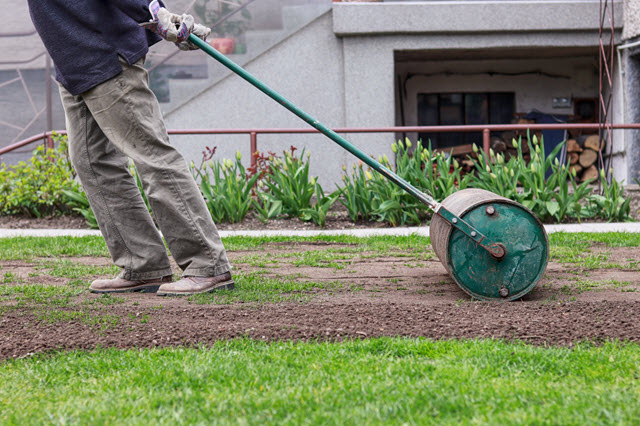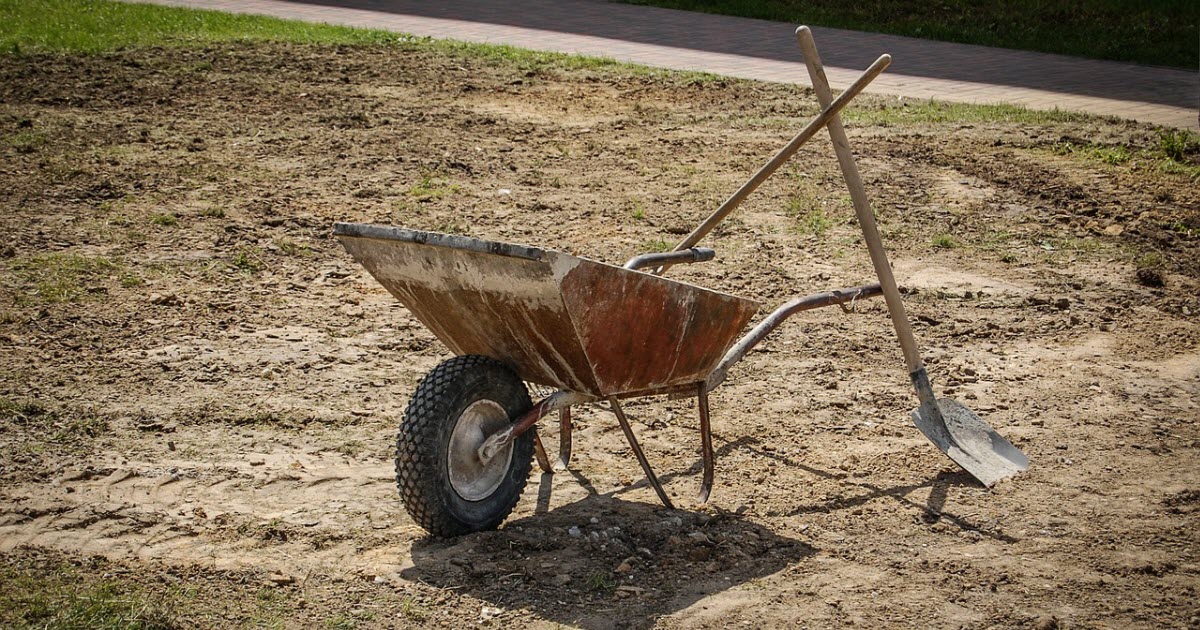Many times the idea of regrading a yard can be intimidating, but if you have a smaller yard or simply want to regrade a certain area of your yard to improve drainage, it’s a project you can do without renting heavy equipment. Today I’ll explain how to grade a yard by hand so you can skip the tool rentals and save some money.

This article was last updated on by Lawn Chick Owner Sarah Jameson
Article content reviewed for accuracy by Horticulturist Arthur Davidson, A.S.
With small areas of lawn, you won’t need a Bobcat or tractor, so there’s no need to pay expensive rental fees. You can grade and level the space by yourself with tools you probably already have in your garage if you have low areas that are shallower than one inch.
In this article, I’ll go over everything you need to know, explaining how to grade a yard by hand step-by-step.
I’ll share the tools required to do the grading yourself, as well as some tips to save your back and get a great result.

Let’s get into it, discussing how to regrade your lawn by hand to smooth out both small holes and depressions, and to correct deeper, more pronounced holes and slopes.
| LawnChick.com is reader supported. If you make a purchase after clicking a link, I may earn a commission at no additional cost to you. |
How to Grade a Yard by Hand (small holes & depressions)
Before you begin filling in and regrading areas with small holes and depressions, you need to prepare your lawn.
Prepare Your Lawn for Grading
Before starting, examine the area around the base of your house. Whenever changing the grading on your property it’s critical to make sure that your yard slopes away from your home so water doesn’t run back toward your structure.
Look for any spots that are lower than those around it where water could collect and pool.

It’s also essential to make the ground softer and soil looser to have an easier time working with it. You can do this by using a cultivator or tiller, or for small areas, you can use an iron rake and shovel to loosen the dirt.
It’s also a good idea to find out the slope of your yard from the base of your house’s foundation. You can do this with the following tools:
- String
- 2 wooden stakes
- A string level, a brick layer’s level, or a carpenter’s level (a few bucks on Amazon)
Check your lawn for any low spots or grooves from vehicle damage that are causing unevenness. Problems with drainage, like cracks in pipes, might be causing these issues. Underground pipes could be leaking and causing the ground to settle unevenly.
If you have dogs, there are probably areas where they did some digging.

Build up the uneven areas with fill dirt. Continue to check your measurements as you go, to make sure you’re keeping within the grade slope you want.
Any areas that are only slightly lower, to a maximum of three-quarters of an inch, can simply be filled in with topsoil, and raked smooth.
Replanting Your Grass
Once this is completed, flatten out your lawn and prepare to plant new grass seed. Go to the areas where you’ve laid down topsoil, and flatten it using:
- A lawn roller (like this one on Amazon)
- The back part of an iron landscaping rake
- Your feet to flatten out the places where you put topsoil

Water those areas so that the soil will become more settled and compact. Once you’ve finished watering, add more topsoil to any areas where there are still low spots.
Wait about three days after you do this, then lightly loosen the new soil and add some grass seed, lightly mulching it with peat moss or straw to keep the birds away and keep the seed moist.
You should water these areas lightly 3-5 times a day for the first week to keep the new seed moist so it can properly germinate and sprout. You don’t want it to dry out, but you also don’t want to water so much that it washes away.
What if the Low Spots are Deeper than One Inch?
If you have low spots that are deeper than one inch on your lawn, you will have to follow different steps for leveling your lawn.
- Cut out an area surrounding the recessed area of lawn using a flathead shovel (I own this Razorback model which I got at Home Depot).
- Cut about 2 inches into the soil. Keep the shovel at an even height and cut around the area. This will help to ensure that you’ll have the same soil thickness beneath the grass.
- Peel back the turf layer and apply some additional topsoil beneath the soil. Keep doing this until you’ve achieved a height that is the same as the area surrounding it.
- Flatten down the area with the back of a shovel or your feet Fill any gaps using the top dressing.
- If you’d like, apply some grass seed to the gap areas and water on a regular basis.
Why is it Important to Grade Your Yard?
If you’re a new homeowner or just not very experienced with lawns, you might wonder why you need to grade your yard.
Well, it’s an important project for a few reasons.
The main reason is the fact that proper grading will make sure that the rainwater or runoff drains properly.

Avoiding standing water, wet areas, and water draining toward your home will make your yard more pleasant, and prevent damage to your yard or structures.
The grading of your yard should always slope at an angle away from your house. This prevents water from pooling beside your house’s foundation, which can lead to expensive repairs due to leaks and flooding.
Proper grading also prevents pools of standing water in your yard. These quickly become stagnant and can become a breeding ground for mosquitoes.
If you’ve noticed any water coming into your basement, check to see if the slope of your lawn may be the cause. If so, grade your lawn so that the water is kept away from the foundation of your home.
Plan Your Grading Project
Remember to plan out your grading project before you start work. You want to make sure that you have everything you need at hand, to save yourself any extra headaches, hassles, and extra trips to the store.
There’s nothing worse than a project that should take a few hours stretching to consume your entire weekend.
My Recommended Tools
At the minimum, I recommend having the following tools and equipment on-hand for a lawn regrade:
- Iron Rake
- Spade
- Flathead shovel
- Wheelbarrow
- Topsoil for fill
- Grass seed and seed mulch
- Hose to water in the new seed
You may be able to get by without some of these tools if you have a small job, and you may want to invest in more tools or rent equipment for larger jobs.

Remember that you will need to remove ornamental plants from the area you want to grade beforehand. You can temporarily pot these plants, or moisten their root ball and place them on a tarp in the shade.
Make sure to dig a healthy root ball for each plant and get them back into the ground promptly after you’ve levelled your yard.
Regrading Your Yard by Hand Can be Painless
Grading and leveling your lawn is a project that homeowners can often do themselves without any expensive equipment.
But if you have a large property with significant grading issues, it might make sense to rent some equipment. Or you could hire a landscaping company to do the job for you.
Now that you understand how to grade a yard by hand, all that’s left is to do the work!
Once you have graded your lawn, you will have greater peace of mind, understanding that your home is protected. It feels great to know you are taking care of your property.

Mowing your lawn will be easier, and the curb appeal of your home will be improved. Good luck!










